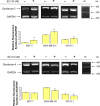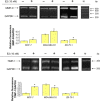Estradiol-estrogen receptor: a key interplay of the expression of syndecan-2 and metalloproteinase-9 in breast cancer cells
- PMID: 19383343
- PMCID: PMC5527808
- DOI: 10.1016/j.molonc.2008.06.002
Estradiol-estrogen receptor: a key interplay of the expression of syndecan-2 and metalloproteinase-9 in breast cancer cells
Abstract
Estrogens are related with the growth and development of target tissues and play a critical role in breast cancer progression. The effects of estrogens are mediated by the estrogen receptors ERalpha and ERbeta, which are members of the nuclear steroid receptor superfamily. To date, it is not known how these hormones elicit many of their effects on extracellular matrix molecules and how these effects can be connected with ER expression. For this purpose, the effect of estradiol on ER expression as well as on proteoglycan and metalloproteinase expression was studied. The effect of E2 on extracellular matrix molecule expression has been studied using ERalpha suppression in breast cancer cells. Our studies using ERalpha-positive MCF-7 cells show that estradiol affects the expression of syndecan-2, but not of syndecan-4, through ERalpha. Furthermore, the ability of estradiol to affect MMP-9 and TIMP-1 expression is connected with ERalpha status. Together, these data demonstrate the significant role of ERalpha on mediating the effect of estradiol on extracellular matrix molecules.
Figures






References
-
- Alarid, E.T. , Bakopoulos, N. , Solodin, N. , 1999. Proteasome-mediated proteolysis of estrogen receptor: a novel component in autologous down-regulation. Mol. Endocrinol 13, 1522–1534. - PubMed
-
- Ali, S. , Coombes, R.C. , 2000. Estrogen receptor alpha in human breast cancer: occurrence and significance. J. Mammary Gland Biol. Neoplasia 5, 271–281. - PubMed
-
- Borras, M. , Hardy, L. , Lempereur, F. , El Khissiin, A.H. , Legros, N. , Gol-Winkler, R. , Leclercq, G. , 1994. Estradiol-induced down-regulation of estrogen receptor. Effect of various modulators of protein synthesis and expression. J. Steroid Biochem. Mol. Biol. 48, 325–336. - PubMed
MeSH terms
Substances
LinkOut - more resources
Full Text Sources
Research Materials
Miscellaneous

